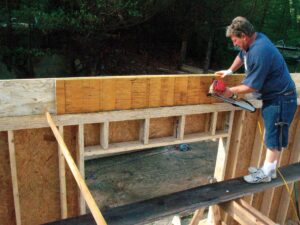what is a header in construction?A header in construction is a crucial structural component that supports loads and transfers them to other structural elements. It is typically used over openings such as doors and windows to maintain the structural integrity of a building.
Here is an in-depth look into headers, covering their purpose, types, materials, installation, and related considerations.
Purpose of Headers
Headers play a vital role in construction for several reasons:
- Load Distribution: Headers distribute the weight of the structure above an opening to the adjacent framing members. This prevents the load from directly bearing down on the openings, which could cause structural failure.
- Support Openings: In walls, openings for doors, windows, or other fixtures need to be supported to maintain the structural integrity of the building. Headers provide this support.
- Structural Integrity: Headers help maintain the overall stability of the structure by evenly distributing loads and preventing sagging or collapse over openings.

Types of Headers
Headers can be categorized based on their location and the type of load they support:
- Interior Headers: These headers are used within the building to support interior doors and windows. They usually carry less load compared to exterior headers.
- Exterior Headers: Exterior headers support the openings in the external walls, bearing heavier loads from the roof and upper floors.
- Non-Load Bearing Headers: These are used in walls that do not support any weight from the structure above. They primarily provide stability and support for the wall opening.
- Load Bearing Headers: These headers support significant weight from the structure above, such as floors and roofs. They must be designed and constructed to handle these loads safely.
Materials for Headers
Headers can be constructed from various materials, depending on the building requirements, the load they need to support, and the architectural design. Common materials include:
- Wood: Traditional and widely used in residential construction. Wood headers are typically made from dimensional lumber like 2x4s, 2x6s, 2x8s, etc., nailed or screwed together to achieve the required strength.
- Engineered Wood: Includes products like laminated veneer lumber (LVL), glulam (glued laminated timber), and parallel strand lumber (PSL). These materials are stronger and more dimensionally stable than traditional lumber.
- Steel: Used in commercial and industrial buildings or where high loads are expected. Steel headers can be I-beams, channels, or other structural steel shapes.
- Concrete: Reinforced concrete headers are used in masonry or concrete construction. They are strong and durable, suitable for supporting heavy loads.
Design Considerations
When designing headers, several factors must be taken into account:
- Load Calculation: Accurate determination of the loads the header will support is critical. This includes dead loads (weight of the structure and materials) and live loads (occupants, furniture, snow, wind, etc.).
- Span: The length of the opening that the header needs to span affects its size and material. Longer spans require stronger and sometimes deeper headers.
- Building Codes: Adherence to local building codes and regulations ensures the header is designed to meet safety and performance standards.
- Thermal Performance: In exterior walls, headers can affect the thermal performance of the building envelope. Insulated headers or those made from materials with better thermal properties can help improve energy efficiency.

Installation Process
Installing a header involves several steps, ensuring it is done correctly to provide the necessary support:
- Preparation: Remove the wall covering to expose the framing where the header will be installed. Measure and mark the location of the header.
- Support the Structure: Before cutting the opening, temporary supports (such as jack studs or shoring) are put in place to bear the load during construction.
- Cut the Opening: Cut the wall studs at the marked location. Ensure the cuts are clean and straight.
- Install the Header: Position the header in place. It usually rests on king studs (full-length studs) and jack studs (shortened studs that support the header).
- Secure the Header: Nail or screw the header to the king and jack studs. Ensure it is level and securely fastened.
- Remove Temporary Supports: Once the header is in place and secured, remove the temporary supports.
- Finish the Opening: Install any necessary framing around the opening and replace the wall covering.
Common Issues and Solutions
Several issues can arise with headers, and understanding how to address them is important for maintaining structural integrity:
- Sagging Headers: Often caused by undersized headers or inadequate support. Solution: Replace with a properly sized header or add additional support.
- Cracking: Can occur in masonry headers due to settling or excessive loads. Solution: Reinforce the header or repair the masonry.
- Thermal Bridging: In exterior walls, headers can create a thermal bridge, reducing energy efficiency. Solution: Use insulated headers or apply additional insulation around the header.
- Water Damage: Especially in wood headers, water infiltration can cause rot and weakening. Solution: Ensure proper flashing and sealing to prevent water ingress.
Conclusion
Headers are a fundamental element in construction, providing essential support and load distribution over openings. The choice of material, accurate load calculations, adherence to building codes, and proper installation techniques are critical to their performance and longevity. Understanding the role of headers and the considerations involved in their use ensures a safe, stable, and durable structure.
Read Also. Best Tile Floor Underlayment Options | How to use them